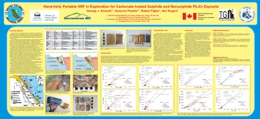| Publication Summary
|
| Issue ID: | GF2011-06 |
| Title: | Hand-held, Portable XRF in Exploration for Carbonate-hosted Sulphide and Nonsulphide Pb-Zn Deposits |
| Author(s): | Simandl, G.J., Paradis, S., Fajber, R., Rogers. N. |
| Series Name: | GeoFile |
| Publication Year: | 2011 |
| NTS Map Sheet(s): | 082;083;092;093;094;102;103;104;114 |
| Place Keyword(s): | British Columbia |
| Lat/Long (NSWE): | 60, 48, -140, -114 |
| Theme Keyword(s): | Portable XRF, Carbonate-hosted, exploration |
| Download(s): | |
Abstract:  | Carbonate-hosted nonsulphide base metal mineralization is derived from sulphide deposits by supergene processes. In the field such occurrences can be described as ‘red ores’ or ‘white ores’. Red ores consist mainly of Fe-oxyhydroxides: goethite, hematite, and hemimorphite, as well as minor smithsonite, hydrozincite and cerussite (+/- vestiges of galena ). They are difficult to distinguish macroscopically from barren gossans. White ores consist mainly of hemimorphite, smithsonite, and hydrozincite, as well as minor Fe-oxyhydroxides. In some cases white ores are difficult to distinguish from the enclosing carbonate host rock. Samples from the red and white nonsulphide mineralization were analysed first using portable hand-held X-Ray Fluorescence (XRF) spectrometry and secondly using laboratory ICP-MS/ICP-ES methods (following lithium metaborate fusion). Comparison between the methods indicates that the portable hand-held XRF is a useful field tool in exploration for carbonate-hosted nonsulphide mineralization. The instrument is able to distinguish between barren, moderately mineralized and high grade mineralized samples; making it useful where rapid decisions are needed (on a drill site, during helicopter supported geological work, or for semi-quantitative verification of ore grades at a mine site). Our tests also indicate that currently available portable hand-held XRF analysis is not a substitute for analytical laboratory methods (such as ICP-MS/ICP-ES or assays). |





